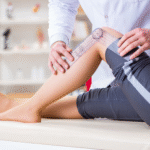Living with arthritis in the knees can feel like a daily challenge. The stiffness, swelling, and pain often make simple tasks—like walking up stairs or standing from a chair—difficult. While medication and treatments can help, one of the most effective and natural ways to manage arthritis pain is exercise.
At first, exercising with sore knees might sound impossible, but the right movements can actually reduce pain, improve flexibility, strengthen muscles, and protect your joints. In this guide, we’ll explore safe and effective exercises for arthritis pain in the knees, explain why they work, and share tips for making them part of your routine.
Why Exercise Helps with Knee Arthritis
When arthritis affects your knees, the cartilage that cushions your joints wears down. This can lead to pain, stiffness, and limited movement. Exercise may not reverse arthritis, but it provides huge benefits:
- Strengthens muscles: Strong muscles around the knees act like shock absorbers, easing stress on the joint.
- Improves flexibility: Gentle stretching prevents stiffness and keeps your knees moving more freely.
- Reduces pain: Movement increases blood flow, reduces inflammation, and helps manage discomfort.
- Supports weight control: Exercise helps you maintain a healthy weight, which reduces pressure on your knees.
- Boosts mood: Regular physical activity releases endorphins, helping you feel better mentally and emotionally.
Types of Exercises for Arthritis Pain in the Knees
Not all exercises are suitable if you have arthritis. High-impact activities like running or jumping can worsen pain. Instead, focus on low-impact exercises that are gentle on your joints but still effective.
1. Range of Motion Exercises
These exercises keep your joints flexible and reduce stiffness. They involve moving your knees through their full motion.
Examples:
- Heel Slides: Sit or lie on your back with legs straight. Slowly slide one heel toward your buttocks, bending your knee, then return to the starting position. Repeat 10–15 times.
- Seated Knee Extensions: Sit on a chair with feet flat. Slowly extend one leg until it’s straight, hold for 3 seconds, then lower. Repeat 10 times per leg.
2. Strengthening Exercises
Stronger thigh, hip, and calf muscles provide better support to your knee joints, easing arthritis pain.
Examples:
- Straight Leg Raises: Lie on your back, bend one knee, and keep the other straight. Slowly lift the straight leg to the level of the bent knee, hold, then lower. Repeat 10–15 times.
- Wall Squats (mini squats): Stand with your back against a wall, feet shoulder-width apart. Slowly slide down the wall a few inches (not too deep), hold for 5 seconds, then slide back up. Repeat 5–10 times.
- Step-Ups: Step onto a low platform or step with one foot, then bring the other foot up. Step down carefully. Repeat 10 times per leg.
3. Stretching Exercises
Stretching helps ease stiffness, improves posture, and reduces the risk of injury.
Examples:
- Hamstring Stretch: Sit on the edge of a chair, straighten one leg out in front of you with your heel on the floor. Lean forward gently until you feel a stretch in the back of your thigh. Hold 20–30 seconds.
- Quadriceps Stretch: Stand holding onto a wall for balance. Bend one knee and gently pull your ankle toward your buttocks, keeping knees together. Hold 20–30 seconds per leg.
- Calf Stretch: Stand facing a wall, place your hands against it, and step one leg back. Keep your heel on the ground and bend your front knee until you feel a stretch in the back leg. Hold 20–30 seconds.
4. Low-Impact Aerobic Exercises
Cardio helps with overall health, weight control, and endurance without putting too much pressure on your knees.
Options include:
- Walking (at your own pace, on even surfaces)
- Cycling (stationary or outdoor bike)
- Swimming or Water Aerobics (water supports your body, easing pressure on knees)
- Elliptical Machines (gentler than running on a treadmill)
Aim for at least 20–30 minutes, 3–5 days per week, at a comfortable pace.
5. Balance and Stability Exercises
These help prevent falls and improve joint control, especially important if arthritis has weakened your knees.
Examples:
- Single-Leg Stands: Hold onto a sturdy chair, lift one foot slightly off the ground, and balance for 10–15 seconds. Switch legs.
- Heel-to-Toe Walk: Walk in a straight line, placing the heel of one foot directly in front of the toes of the other. Take 10–15 steps.
Tips for Exercising with Knee Arthritis
Exercising with arthritis requires a gentle, mindful approach. Here are some tips to make it safe and effective:
- Start Slowly – Don’t push too hard. Begin with 5–10 minutes and gradually increase.
- Warm Up First – Gentle movements or a warm shower can loosen joints before exercising.
- Listen to Your Body – Mild discomfort is normal, but sharp pain means stop.
- Stay Consistent – Regular exercise works better than occasional intense sessions.
- Use Support if Needed – A cane, knee brace, or supportive shoes can make exercising safer.
- Apply Heat or Ice – Heat can relax stiff joints before exercise, and ice can reduce swelling afterward.
Sample Weekly Exercise Plan for Knee Arthritis
| Day | Activity | Duration |
|---|---|---|
| Monday | Range of motion + stretching | 20 mins |
| Tuesday | Walking or cycling (low impact cardio) | 25 mins |
| Wednesday | Strength training (leg raises, squats) | 20 mins |
| Thursday | Swimming or water aerobics | 30 mins |
| Friday | Balance training + stretching | 15 mins |
| Saturday | Light walk or yoga | 20 mins |
| Sunday | Rest or gentle stretches | — |
When to See a Doctor
Exercise is safe for most people with arthritis, but you should consult your doctor if you experience:
- Severe swelling or redness in the knee
- Pain that gets worse after exercise and doesn’t improve with rest
- Sudden inability to move the knee
- Signs of injury (sharp pain, popping sound, or instability)
A physical therapist can also design a personalized exercise plan based on your condition.
Conclusion
Arthritis in the knees can be frustrating, but exercise is one of the best ways to fight back. By focusing on gentle, low-impact movements that build strength, improve flexibility, and support joint health, you can significantly reduce pain and improve your quality of life. Remember, the key is consistency and listening to your body.
Incorporating exercises for arthritis pain in the knees into your daily routine doesn’t just help with mobility—it helps you regain control of your life.
FAQs about Exercises for Arthritis Pain in the Knees
1. Can exercise make knee arthritis worse?
No, the right kind of exercise actually protects your knees. High-impact activities may worsen pain, but low-impact exercises like swimming, cycling, and gentle strength training are beneficial.
2. How often should I exercise if I have arthritis in my knees?
Aim for at least 4–5 days a week, mixing stretching, strength, and low-impact cardio. Even 10–15 minutes a day can make a difference.
3. Is walking good for knee arthritis?
Yes, walking is a safe and effective exercise for most people with arthritis. Just choose flat, even surfaces and wear supportive shoes.
4. What exercises should I avoid with knee arthritis?
Avoid high-impact movements like running, jumping, or deep lunges and squats that put excessive strain on your knees.
5. Should I use weights when strengthening my legs?
You can start with bodyweight exercises. If you feel comfortable and strong, add light weights or resistance bands for extra support—but never push through sharp pain.



